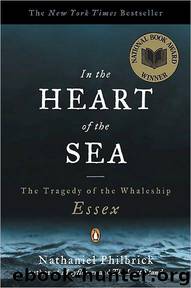In the Heart of the Sea: The Tragedy of the Whaleship Essex by Nathaniel Philbrick

Author:Nathaniel Philbrick
Language: eng
Format: mobi, epub
Tags: Pacific Ocean, Shipwrecks - Pacific Ocean, Transportation, Action & Adventure, Mexico, Travel, Essex (Whaleship), United States, Ships & Shipbuilding, Sea Stories, General, Latin America, Fiction, Navigation, Shipwrecks, 19th Century, History
ISBN: 9780141001821
Publisher: Penguin
Published: 1999-01-02T00:00:00+00:00
The Whisper of Necessity
BEFORE THEY LEFT Henderson Island, Chase loaded a flat stone and an armful of firewood into each boat. That first evening back on the water, as both the island and the sun slipped below the western horizon behind them, they put the stones to use as platforms for cooking fires. “[W]e kept our fires going,” Chase wrote, “and cooked our fish and birds, and felt our situation as comfortable as could be expected.”
For a month they had been driven south and even west; now they hoped to sail almost directly east to Easter Island. For this to happen they needed two weeks of westerly breezes. However, at latitude 24° south, they were still in the trades, where for more than 70 percent of the year the wind blows out of the southeast. But that night, as if in answer to their prayers, a strong breeze sprang up out of the northwest, and they steered straight for Easter.
If they were to keep track of their progress east, they needed to find a way to estimate their longitude—something they had not done during the first leg of the voyage. A month of sailing without knowing their east-to-west position had proved to them the necessity of at least attempting to determine it. Before leaving Henderson, they decided to maintain what Chase called “a regular reckoning.” Their noon observation told them their latitude, and by doing as Captain Bligh had done before them—using an improvised log line to gauge their speed and their compass to determine their direction—they could calculate their longitude. The Essex boats were no longer sailing blind.
For three days the northwesterly breeze held. Then, on December 30, the wind shifted into the east-southeast, and for two days they were forced to steer a course well to the south of Easter Island. But by the first day of the new year, 1821, the wind had shifted to the north, and they were once again back on track.
On January 3 they sailed into what Nickerson called “hard weather.” Squalls blasted them from the southwest. “The seas had become so rough,” Nickerson remembered, “that we were fearful that each successive gust would swamp our boats. . . . Every squall was attended with the most vivid flashes of lightning and awful thunder claps, which seemed to cause the very bosom of the deep to tremble and threw a cheerless aspect upon the face of the ocean.”
The next day, the capricious wind shifted to the east-northeast. With their sails trimmed in tight on the port tack, they steered as close to the wind as possible but were still unable to fetch Easter Island. Pollard and Chase came to the same distressing conclusion: they were now too far to the south to have any hope of reaching the island. They searched their Navigator copies for the next closest island “where the wind would allow of our going.” About eight hundred miles off the Chilean coast are the islands of Juan Fernandez and Masafuera.
Download
In the Heart of the Sea: The Tragedy of the Whaleship Essex by Nathaniel Philbrick.epub
This site does not store any files on its server. We only index and link to content provided by other sites. Please contact the content providers to delete copyright contents if any and email us, we'll remove relevant links or contents immediately.
Small Unmanned Fixed-wing Aircraft Design by Andrew J. Keane Andras Sobester James P. Scanlan & András Sóbester & James P. Scanlan(32145)
Navigation and Map Reading by K Andrew(4556)
Endurance: Shackleton's Incredible Voyage by Alfred Lansing(3852)
Wild Ride by Adam Lashinsky(1660)
And the Band Played On by Randy Shilts(1620)
The Box by Marc Levinson(1596)
Top 10 Prague (EYEWITNESS TOP 10 TRAVEL GUIDES) by DK(1569)
The Race for Hitler's X-Planes: Britain's 1945 Mission to Capture Secret Luftwaffe Technology by John Christopher(1529)
The One Percenter Encyclopedia by Bill Hayes(1467)
Girls Auto Clinic Glove Box Guide by Patrice Banks(1366)
Trans-Siberian Railway by Lonely Planet(1346)
Looking for a Ship by John McPhee(1321)
Batavia's Graveyard by Mike Dash(1303)
Fighting Hitler's Jets: The Extraordinary Story of the American Airmen Who Beat the Luftwaffe and Defeated Nazi Germany by Robert F. Dorr(1301)
Troubleshooting and Repair of Diesel Engines by Paul Dempsey(1286)
Bligh by Rob Mundle(1276)
TWA 800 by Jack Cashill(1254)
The Great Halifax Explosion by John U. Bacon(1231)
Ticket to Ride by Tom Chesshyre(1231)
